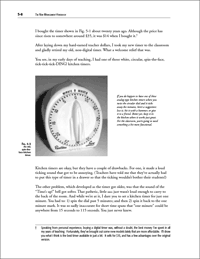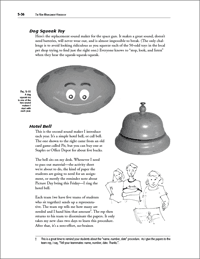

![]()
Goals for this lesson:
-
Learn how "definition" can lead to "control."
-
Understand the importance of sharing a common language with your students.
-
Discover the power of using a digital timer.
-
Find out how to have fun with classroom toys.
-
Learn how to utilize the power of the right-brain.
Sample Pages
Just click on a page image to see the page in PDF format.


![]()
FAQ Lesson 5
Where do you keep all of your sound making toys?
I keep most of them on, or in, my desk. I use a student desk, one of the double-sized ones normally used by two students. On top of the desk you'll find: 1) a digital timer or two; 2) my hotel bell for passing out papers; 3) my dog squeak for getting attention; and 4) my set of Class Cards.
There are certain toys, though, that are kept on a student's desk. For example, the tone bars that we use to remind students to put "name, number, date" on their papers is held by a student. All I do is nod my head in his direction when I want the three-note tune to be played.
However, when trying to figure out where to place tools and toys, don't limit yourself to flat surfaces. You could hang a sound maker from the ceiling so that it is within reach of your raised hand. Or maybe you could get some double-sided tape and attach a small toy to the wall of your room.
Whatever you decide, the daily practice you'll receive at using your tools and toys will make their eventual location and placement a natural part of how you use them. In other words, don't allow yourself to get too frustrated when they're not immediately at your fingertips the first few weeks. You have to live with things for a while before you understand where they should be kept. Also, it takes a bit of time to develop the habit of returning them to the proper place so that they're at hand the next time you need to use them.
And if the sound maker you need is across the room, don't worry about it. Enjoy the ten-second walk.
How many different sounds can students differentiate?
Depending upon their grade level and general ability, most students can easily learn the meanings to a dozen different sounds. (Just stop and think about all of the musical slogans and jingles you've assimilated over the years. It's got to be close to one hundred. Granted, you wouldn't be able to think of that many. You would have to hear them before you were able to identify them.) All it takes is a bit of time and patience on your part.
Suggestion: Start with the basics--"Stop, look, listen" and "I need to pass out materials"--and live with those for a month before you begin to add other sounds with other messages.
What do I do when the timer beeps and none of my students are finished with the assignment they were given to do?
This happens every now and then, especially when you first begin to use a digital timer to keep track of how much time students have to complete an assignment. There are two ways you can go.
1. If you become aware of the fact that the time frame you established is not going to allow enough time for your students to complete the assignment and the timer hasn't beeped yet, stop the timer, get their attention, and make an announcement. Tell them that you goofed and need to add more time. By doing this before the timer beeps, you'll be reinforcing the fact that the beep means that it is time to stop working.
2. If you become aware of the situation after the timer has beeped, you should probably just tell your students that the timer is telling us that it's time to stop. Tell them that they'll be able to work on the assignment tomorrow in class.
Either way you go, it's important to be flexible. It's okay to adjust the time limits as long as you don't make a habit of it. Too much flexibility will cause your students to see every time standard as something to be ignored.
